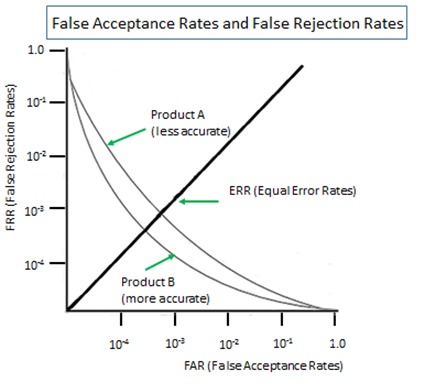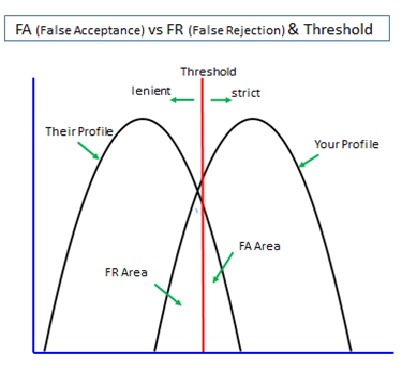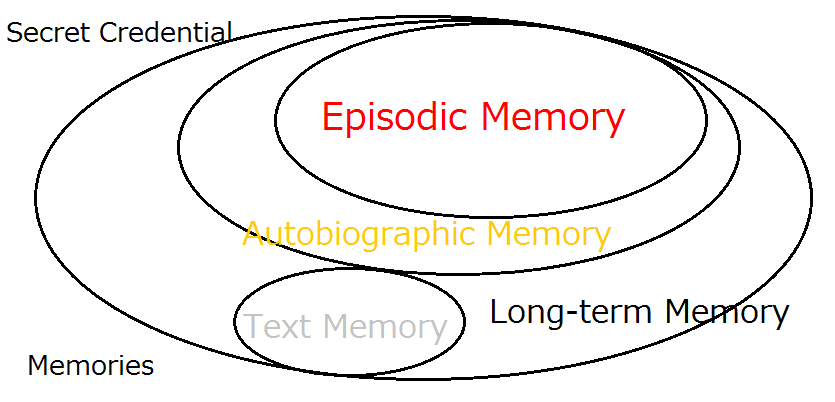‘Informed’ consent must be ‘Respected’. ‘Misinformed’ Consent must be ‘Corrected’.
In February 2018 we felt a big shockwave to have heard a mind-bogglingreport of unnecessary deaths presumably brought by biometrics misunderstood from India where the biometrics; is mandatory for its Aadhaar-based Public Distribution System. There have since been intriguing new findings.
According to a report from India, actual False Acceptance Rates turned out to be 6% for fingerprints and 8.5% for iris scans in the large-scale use case of Aadhaar, which may look far higher than you have heard. And, a follow-up report says that a lock function has been introduced for the biometrics data.
By the way, the reports refer to ‘failure’ or ‘glitch’ of biometrics, but it is not necessarily correct. 'False Rejection' as against 'False Acceptance' is inherent in biometrics; there is no biometrics that is free from False Rejection. Let us explain this point closely.
A graph (*1) below shows the False Acceptance Rates (FAR) and False Rejection Rates (FRR) of two biometrics products - one relatively more accurate and the other less accurate.

What this graph indicates is, firstly, that FAR and FRR are not the variables that are independent from each other, but are dependent on each other.
A FAR could be fixed only against a certain FRR, i.e., both variables can be positioned only at the same single point on the same single curve. In other words, the couple of a FAR and a FRR can exist only in a certain combination.
Secondly, it also indicates that the lower a FAR is, the higher the corresponding FRR is. The lower a FRR, the higher the corresponding FAR. That is, FAR and FRR are not just mutually dependent but are in a trade-off relation
The level of a FAR that rejects a twin would have to bring the level of a FRR that rejects the registered user very frequently. The level of a FRR that eliminates the need of a fallback means would have to bring the level of a FAR that accepts nearly anyone.
Thirdly, also indicated is that the more accurate the biometrics sensor becomes (the lower the Equal Error Rate becomes), the curve goes downwards/leftwards in this graph. But, when a FAR is 0 (zero), the corresponding FRR still remains close to 1 (one). When a FRR is 0 (zero), the corresponding FAR remains close to 1 (one).
Another graph (*2) helps us to grasp how FAR and FRR are mutually dependent and also in a trade-off relation.

Move the threshold to the right (more strict) and we would see the combination of a lower FAR and a higher FRR. Moving it to the left (more lenient), the outcome would be the combination of a higher FAR and a lower FRR.
The presence of False Rejection, however close to 0 (zero) the rate might be, would require a fallback means against the False Rejection.
If the officials responsible for the Aadhaar-based PDS had been informed of the above, they must have provided a fallback means in case of the false rejection. Then this kind of misery could have been avoided. We have to wonder how it was possible that these people were not advised of the issue of false rejection.
The touted merits of biometrics were (a) security higher than passwords and (b) convenience better than passwords. We have been trying to demystify (a) and the actual case of Aadhaar and the like will hopefully be demystifying (b).
* Look at this brief video for demystification (a) of biometrics.
Biometrics in Cyber Space -"below-one" factor authentication
Hitoshi Kokumaiの記事
ブログを見る
We today take up this report “NSA: We 'don't know when or even if' a quantum computer will ever be a ...

There is actually a valid methodology that enable us to maximize the entropy of the secret credentia ...

We’ve come up with a slide presentation for “Bring a healthy second life to your legacy password sys ...
この職種に興味がある方はこちら
-

総合職(営業)
次の場所にあります: beBee S2 JP - 1日前
大東建託株式会社 札幌市, 日本 フルタイム· ■ この求人のポイント · 年齢は関係なし未経験から年収1,000万円以上も夢じゃない · 【東証プライム上場】業界No.1の実績で安定成長中 · 【転勤なし】慣れ親しんだ街の支店で安心して働く · 【高水準の給与】社員の平均年収は850万円 · 【働きやすさ】年休125日/フレックス/福利厚生抜群 · 【年齢不問】未経験入社の40代・50代も多数活躍中 · 【研修&サポート】専属トレーナーによる教育体制あり · 圧倒的なブランド力にあなたの誠実さをプラスする――《再出発》は業界のリーディングカンパニーで · ★業績好調につき全国の支店で増員募集し ...
-

アイリスト
次の場所にあります: beBee S2 JP - 3日前
L'atelierJitta(ラトリエジッタ) 船橋市, 日本 正社員 アルバイト 業務委託更新日: · 【業務内容】アイリストとしてのサロンワーク全般 · 【雇用形態】 正社員 アルバイト 業務委託 · 【勤務地】津田沼駅・新津田沼駅より徒歩5分のネイル&アイラッシュサロン · 【給与】【正社員】 · 基本給:220,000円~250,000円+歩合+指名/店販手当 · ※基本給は施術時間により決定致します · ※歩合給は最大10%還元 · 【アルバイト/パート】 · 時給:1,026円+指名/店販手当 · 【業務委託】 · 完全歩合 · ※技術売上の50%還元 · 【試用期間中給与】【未経験で社員希望の方】 · 2ヶ月間:時給 ...
-

総合職(ロボットシステムメーカー)
次の場所にあります: beBee S2 JP - 1日前
ロボットシステムメーカー:求人コード77760 愛知県, 日本 フルタイム■事業内容 · 世界で初めてロボットヘミングシステムの開発に成功した、ロボットシステムの総合メーカーです。同社の手がけるロボットシステムは「設備投資低減」「小スペースによる設置場所の制限の解消」などに貢献。大手自動車メーカーを始めとする製造業へ納入しており、その高い技術開発力が認められ、20を超える特許を取得しています。 · ■ロボットヘミングシステムとは? · 自動車のドアやボンネットは鉄板を切断し製造され、切断面である外周部分は内側に折り曲げられています。巨大なプレス機が担っていたこの折り曲げる加工をロボットで実現させたのが、「ロボットヘミングシステ ...
コメント